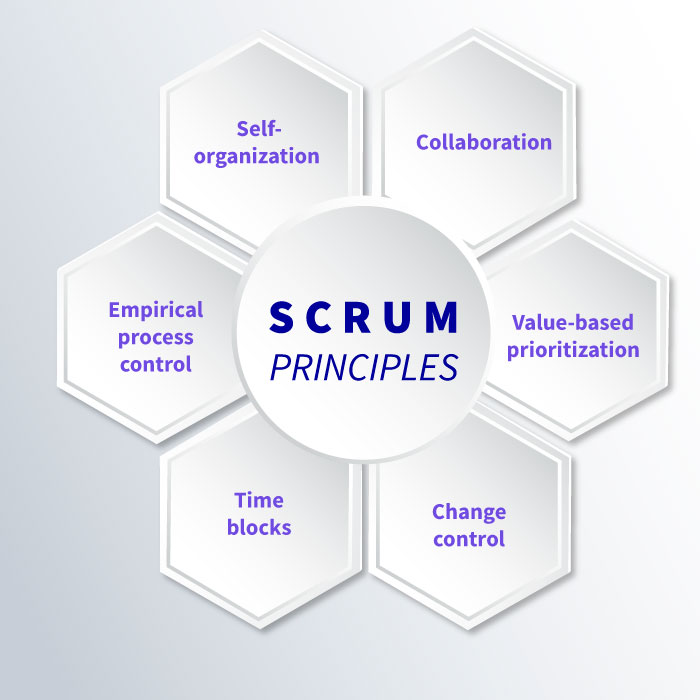Scrum is an adaptative, iterative, flexible, and effective framework that delivers solutions with significant value in a fast way during the development of a project.
There are three key points for the correct implementation of Scrum: the principles, the processes, and the aspects of Scrum.
The Scrum Principles

Empirical process control
Process control in Scrum has three pillars Transparency, Inspection, and Adaptation which allow correct implementation in the processes.
- Transparency focuses on clearly showing stakeholders the development processes. According to the Scrum Guide (2020), “Transparency enables inspection. Inspection without transparency is misleading and wasteful.”
- Inspection constantly reviews the progress of the agreed objectives to identify potential risks or necessary changes within the project through its five key events: Sprint, Sprint planning, Daily Standup, Sprint Review, and Sprint retrospective. The Scrum Guide (2020) mentions that “Inspection enables adaptation. Inspection without adaptation is considered useless. Scrum events are designed to bring about change.”
- Adaptation is the process of adjustments that must be made when there are changes in the project. The adjustments must be made promptly to avoid a deviation from the acceptable limits. According to the Scrum Guide (2020), “A Scrum team is expected to adapt the moment it learns anything new through inspection.”
Self-organization
A Scrum team is a small group of no more than nine people: a Scrum Master, a Product Owner, and a group of Developers. The Scrum team is responsible for creating a valuable increment for the project during the sprint.
A self-organization team should have clear goals such as:
- Deliver tangible results and add value.
- To have a clear view of project progress.
- Maximize the knowledge of all members of the multidisciplinary team.
- Seek to ensure that the work performed is always proactive.
- Be open to learning.
- Be updated on new skills and knowledge.
Collaboration
The collaboration of the Scrum team allows the fulfillment of the objectives to be accurate. The collaboration has three specific points: knowledge, articulation, and appropriation.
- Knowledge lets everyone involved know the progress, risks, and adjustments needed to meet the objectives.
- Articulation is the integration process between work performed by each team member.
- Appropriation is the adaptation that the team will have to the different changes that arise.
Value-based prioritization
Prioritization is one of the basic principles to boost the structure and functionality of the entire Scrum framework.
Prioritization is based on the following:
- Risks: Considers those that do not allow the achievement of the objectives.
- Dependency: Considers those dependencies with one or several future increments.
- Value: This value can be added or diminished according to the decision-making process.
Change control
Change control is one of the most critical points in development as it allows for any change requested by the client as the team gains more knowledge about the project.
Time blocks
Specific definitions of time blocks enable benefits such as an efficient development process, less general cost, and high speed in the development teams.
Scrum has defined specific times for its five main events:
- Sprint: One to four weeks, according to the project's complexity.
- Daily Standup: Has a maximum duration of fifteen minutes and must be carried out every day at the same place and time to expedite the process.
- Sprint Planning: Eight hours for a 4-week sprint.
- Sprint Review: Four hours for a 4-week sprint.
- Sprint Retrospective: Four hours for a 4-week sprint.

The Scrum Process
Scrum has nineteen general methods, which we can divide into five stages.
Initiating
This is the initial stage in which the project bases are established. Six processes take place during this stage:
- Create the vision of the project.
- Identify the Scrum Master and project stakeholders.
- Form de Scrum team.
- Develop epics.
- Create the prioritized product backlog.
- perform release planning.
Planning and estimation
In conjunction with the implementation, review, and retrospective stages, the planning and estimation stage create a cycle that provides insight into progress during the project. Six processes take place during this stage:
- Create user stories.
- Estimate user stories.
- Engaging user stories.
- Identify tasks.
- Estimate tasks.
- Update Sprint Backlog.
Implementation
This stage is part of the cycle to allow communication between the scrum team. Three processes take place during this stage:
- Create deliverables.
- Performing Daily Standup.
- Refine the prioritized product backlog.
Review and retrospective
This stage closes the review cycle during the development of the project. Two processes take place during this stage.
- Demonstrating and validating the sprint.
- Sprint retrospective.
Release
The final stage of the project allows validation of the delivery and release process. Two processes take place during this stage.
- Send deliverables.
- Retrospective of the liberation
The Aspect of Scrum
Organization
The organization in the agile methodology is divided into core roles and no core roles.
The core roles can be defined as the scrum team, a small team of cross-functional people usually could have up to ten people. The scrum team is conformed of the following:
- Product Owner: Responsible for informing the team about the customer’s requirements. The Product Owner is the voice of the customer.
- Scrum Master: Responsible for guiding, facilitating, and teaching Scrum practices to the team, ensuring that scrum events are completed as planned.
- Developer team: Responsible for understating the business needs and creating project deliverables.
- On the other hand, no-core roles are those that are part of the project, but are not fully involved with the Scrum process, for example:
- Partners: Customers, users, or sponsors who occasionally interact with the scrum team.
- Suppliers: External individuals or organizations that provide products or services outside the main boundaries of the project organization.
- Scrum guidance body: Composed of a group of documents and/or groups of experts that serve as a consultation or advisory structure.
Business justification
Based on the concept of value-based delivery helps projects benefit through adaptability and iterative development.
Quality
Quality represents one of the most critical parts of the project because the deliverables or product can meet the acceptance criteria provided by the customer.
Change
Change in projects is always present. Scrum has processes designed to accept these changes and mitigate the impact of these changes on the project’s scope.
Risk
A risk is an uncertain event or circumstance that can affect a project’s objectives. These risks can place the project in a successful or unsuccessful environment.
The Benefits of Scrum
Scrum being an agile methodology, offers several benefits, such as:
- Expectation management: Events throughout the sprint allow the team to be aware of the progress and thus inform the customer of exactly what will be delivered in the progress presentation sessions.
- Enables communication: Scrum, through its events, allows constant communication between the scrum team and stakeholders.
- Flexibility and adaptation: Scrum allows the customer and the team a process that can accept change through its iterative methods making the project development dynamic.
- Definition of responsibilities: Scrum precisely defines the responsibilities and limitations of each one of the team members, so each one knows what to focus on to achieve the fulfillment of their work.
- Focus teams: By giving a specific period and a limited set of tasks, the team becomes focused and focused on accomplishing these tasks.


